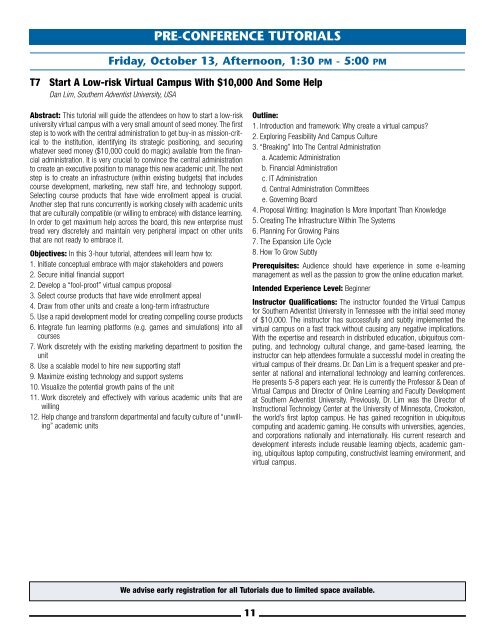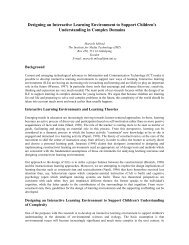PRE-CONFERENCE TUTORIALSFriday, <strong>October</strong> <strong>13</strong>, Afternoon, 1:30 PM - 5:00 PMT6Blended Learning: Situations, Solutions, and Several Stunning SurprisesCurt Bonk, Indiana University and SurveyShare, Inc, <strong>USA</strong>Su Jin Son, University of Illinois, <strong>USA</strong>Eun Jung Oh, graceoh@uga.edu, <strong>USA</strong>Abstract: There is both extensive confusion and much optimism aboutblended learning due to multiple blended learning definitions and approaches.While <strong>the</strong> definitions vary, this session will lay out several different modelsand definitions of blended learning as well as <strong>the</strong> advantages and disadvantagesof blended learning. Importantly, <strong>the</strong> session will include a dozendifferent situations or problems and more than 50 potential blended learningsolutions in many different disciplines and levels of institutions. Many of<strong>the</strong> examples will come from Dr. Bonk’s recent Handbook of Blended learning:Global Perspectives, Local Designs. Workshop leaders will also tap intorecent data he has collected on <strong>the</strong> present and future state of blendedlearning around <strong>the</strong> planet in corporate training as well as higher educationenvironments (US, UK, Korea, China, and Taiwan). Some of this data will surpriseand even stun you! During this session, small teams of participants(instructional designers, trainers, administrators, instructors, students, etc.)will build and later present <strong>the</strong>ir own blended learning models.Objectives:1. Understand <strong>the</strong> different definitions of blended learning and compare toideas about hybrid learning.2. Grasp different ways to blended learning in online environments. Forexample, <strong>the</strong>re are ways to blend synchronous and asynchronous technologies,behavioral and constructivist approaches to instruction, faceto-faceand online course events, students and instructors located in differentplaces, etc.3. Realize <strong>the</strong> range of blended learning models and applications.4. To understand potential blended learning situations and solutions.5. Detail a range of examples of blended learning in a wide variety of contentareas.6. Learn how to create effective blended learning environments.7. Link blended learning ideas to learner needs or preferences.8. Document some of <strong>the</strong> research on blended learning.9. To push research and practice within blended learning in new directions.10. Brainstorm new ways to think about blended learning in one’s organizationor institution.11. To build a personally meaningful and relevant blended learning modelwhich <strong>the</strong>y can take back to <strong>the</strong>ir home institution.12. Create a community <strong>for</strong> sharing blended learning ideas.Outline: Topical Outline (Note: many interactive events will be embeddedin this tutorial)Part I. Blended Learning Overview and Trendsa. Some brief and surprising research data on blended learning in morethan 5 countries (UK, <strong>USA</strong>, Taiwan, China, and Koea)b. Blended learning defined by audiencec. Blended learning defined by expertsd. Blended learning modelse. Advantages and disadvantages of blended learning.f. Begin building own blended learning model in small groups.g. Blended learning researchh. Where is blended learning useful?i. 12 Blended learning situations or problems and 50 solutions.j. Role play problems and situationsk. Questions and answersl. Future of blended learningm. Data collected on <strong>the</strong> present and future state of blended learningin <strong>USA</strong>, UK, China, Taiwan, and Korea.n. Interactive blended learning review and quizo. Finish blended learning model and present back to class.p. Activity: Presentation of modelsPrerequisites: NoneIntended Audience: The primary audience will be higher educationinstructors, administrators, and instructional designers. Corporate trainers,training administrators, HR personnel, and instructional designers, are alsowelcome as are those from governmental, non-profit, and K-12 settings.Some data and examples will come from each of <strong>the</strong>se environments. Theymight be at any level of expertise (beginner, intermediate, or advanced).Those in <strong>the</strong> online learning trenches will benefit <strong>the</strong> most since someideas will come from extensive personal experience teaching online as wellas best pedagogical practices <strong>for</strong> online learning.Intended Experience Level: IntermediateInstructor Qualifications:Curt Bonk (cjbonk@indiana.) is Professor Instructional Systems Technologyand adjunct in <strong>the</strong> School of In<strong>for</strong>matics at Indiana University. Dr. Bonk isalso a Senior Research Fellow with <strong>the</strong> DOD’s Advanced DistributedLearning Lab. He has received <strong>the</strong> CyberStar Award from <strong>the</strong> IndianaIn<strong>for</strong>mation Technology <strong>Association</strong>, Most Outstanding Achievement Awardfrom <strong>the</strong> U.S. Distance Learning <strong>Association</strong>, and Most Innovative Teachingin a Distance Education Program from <strong>the</strong> State of Indiana. Dr. Bonk is inhigh demand as a conference keynote speaker and workshop presenter.He is President of CourseShare and SurveyShare (see http://php.indiana.edu/~cjbonk/).Su Jin Son is pursuing a Ph.D. in Human Resource Education (HRE) atUniversity of Illinois at Urbana-Champaign. She received an Ed.M inEducational Technology from Kyung Hee University in Korea. Su Jin has afull-time work experience in Kyung Hee Cyber University <strong>for</strong> one and halfyears as an instructional designer. She also has diverse hands on researchexperiences, developing e-mentoring program, evaluating e-mentoringprogram, and conducting blended learning projects. Her interests includee-mentoring, implementation of technology in organizations, and blendedlearning in corporate training. Now she is working in HRE online as a graduateassistant in UIUC. She can be reached at sson3@uiuc.eduEun Jung Oh is a doctoral student and a graduate assistant in Departmentof Educational Psychology and Instructional Technology at <strong>the</strong> University ofGeorgia. She received her master’s in instructional systems technology(IST) from Indiana University. Be<strong>for</strong>e her doctoral studies, she used to be anHRD specialist in Samsung SDS, an in<strong>for</strong>mation technology systems integrationservice company in Samsung corporation. Eun Jung also has avariety of experiences related to designing web-based learning programs,consulting, and research. She can be reached at graceoh@uga.edu.10
PRE-CONFERENCE TUTORIALSFriday, <strong>October</strong> <strong>13</strong>, Afternoon, 1:30 PM - 5:00 PMT7Start A Low-risk Virtual Campus With $10,000 And Some HelpDan Lim, Sou<strong>the</strong>rn Adventist University, <strong>USA</strong>Abstract: This tutorial will guide <strong>the</strong> attendees on how to start a low-riskuniversity virtual campus with a very small amount of seed money. The firststep is to work with <strong>the</strong> central administration to get buy-in as mission-criticalto <strong>the</strong> institution, identifying its strategic positioning, and securingwhatever seed money ($10,000 could do magic) available from <strong>the</strong> financialadministration. It is very crucial to convince <strong>the</strong> central administrationto create an executive position to manage this new academic unit. The nextstep is to create an infrastructure (within existing budgets) that includescourse development, marketing, new staff hire, and technology support.Selecting course products that have wide enrollment appeal is crucial.Ano<strong>the</strong>r step that runs concurrently is working closely with academic unitsthat are culturally compatible (or willing to embrace) with distance learning.In order to get maximum help across <strong>the</strong> board, this new enterprise musttread very discretely and maintain very peripheral impact on o<strong>the</strong>r unitsthat are not ready to embrace it.Objectives: In this 3-hour tutorial, attendees will learn how to:1. Initiate conceptual embrace with major stakeholders and powers2. Secure initial financial support2. Develop a “fool-proof” virtual campus proposal3. Select course products that have wide enrollment appeal4. Draw from o<strong>the</strong>r units and create a long-term infrastructure5. Use a rapid development model <strong>for</strong> creating compelling course products6. Integrate fun learning plat<strong>for</strong>ms (e.g. games and simulations) into allcourses7. Work discretely with <strong>the</strong> existing marketing department to position <strong>the</strong>unit8. Use a scalable model to hire new supporting staff9. Maximize existing technology and support systems10. Visualize <strong>the</strong> potential growth pains of <strong>the</strong> unit11. Work discretely and effectively with various academic units that arewilling12. Help change and trans<strong>for</strong>m departmental and faculty culture of “unwilling”academic unitsOutline:1. Introduction and framework: Why create a virtual campus?2. Exploring Feasibility And Campus Culture3. “Breaking” Into The Central Administrationa. Academic Administrationb. Financial Administrationc. IT Administrationd. Central Administration Committeese. Governing Board4. Proposal Writing: Imagination Is More Important Than Knowledge5. Creating The Infrastructure Within The Systems6. Planning For Growing Pains7. The Expansion Life Cycle8. How To Grow SubtlyPrerequisites: Audience should have experience in some e-learningmanagement as well as <strong>the</strong> passion to grow <strong>the</strong> online education market.Intended Experience Level: BeginnerInstructor Qualifications: The instructor founded <strong>the</strong> Virtual Campus<strong>for</strong> Sou<strong>the</strong>rn Adventist University in Tennessee with <strong>the</strong> initial seed moneyof $10,000. The instructor has successfully and subtly implemented <strong>the</strong>virtual campus on a fast track without causing any negative implications.With <strong>the</strong> expertise and research in distributed education, ubiquitous computing,and technology cultural change, and game-based learning, <strong>the</strong>instructor can help attendees <strong>for</strong>mulate a successful model in creating <strong>the</strong>virtual campus of <strong>the</strong>ir dreams. Dr. Dan Lim is a frequent speaker and presenterat national and international technology and learning conferences.He presents 5-8 papers each year. He is currently <strong>the</strong> Professor & Dean ofVirtual Campus and Director of Online Learning and Faculty Developmentat Sou<strong>the</strong>rn Adventist University. Previously, Dr. Lim was <strong>the</strong> Director ofInstructional Technology Center at <strong>the</strong> University of Minnesota, Crookston,<strong>the</strong> world’s first laptop campus. He has gained recognition in ubiquitouscomputing and academic gaming. He consults with universities, agencies,and corporations nationally and internationally. His current research anddevelopment interests include reusable learning objects, academic gaming,ubiquitous laptop computing, constructivist learning environment, andvirtual campus.We advise early registration <strong>for</strong> all Tutorials due to limited space available.11
















